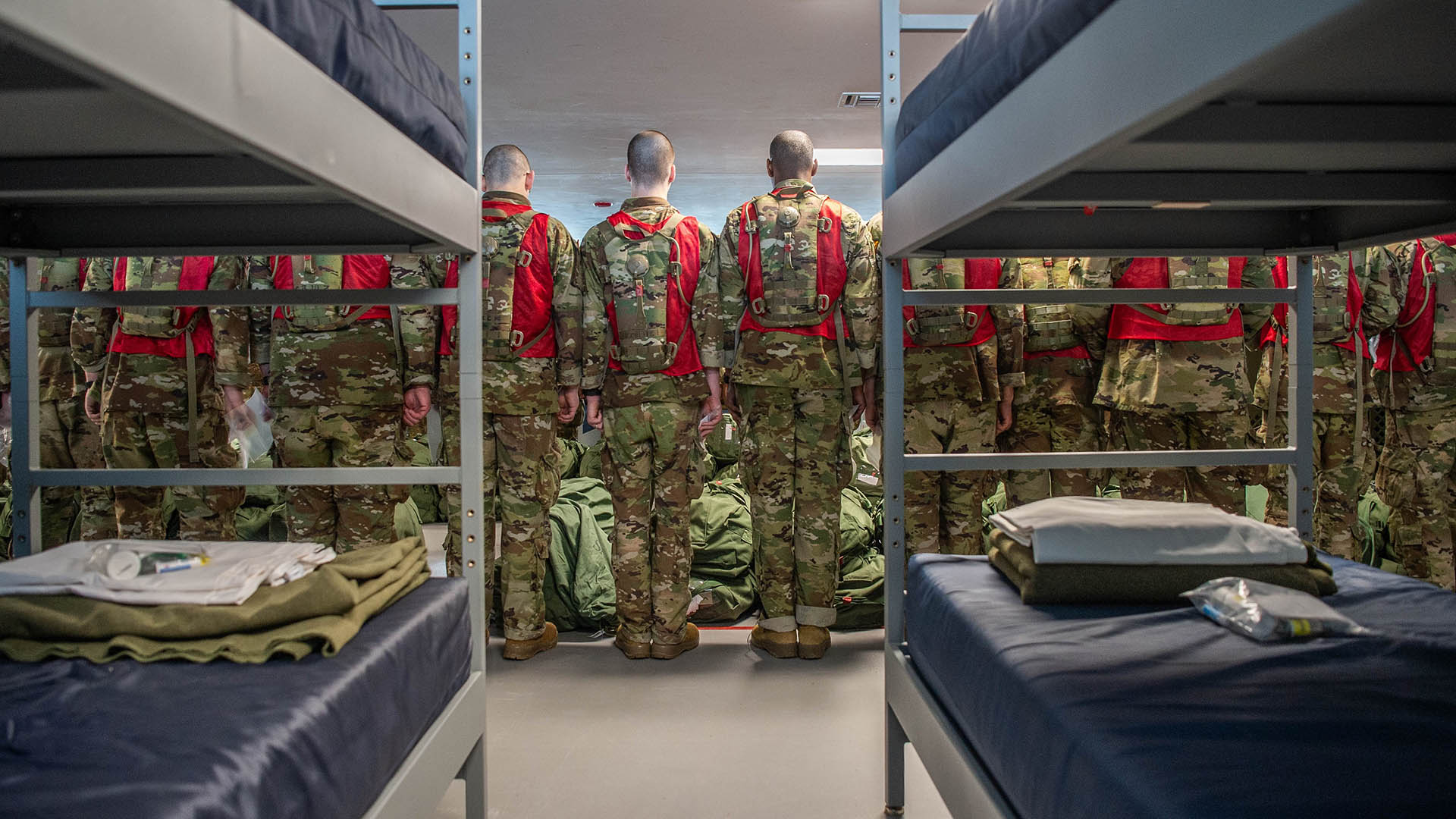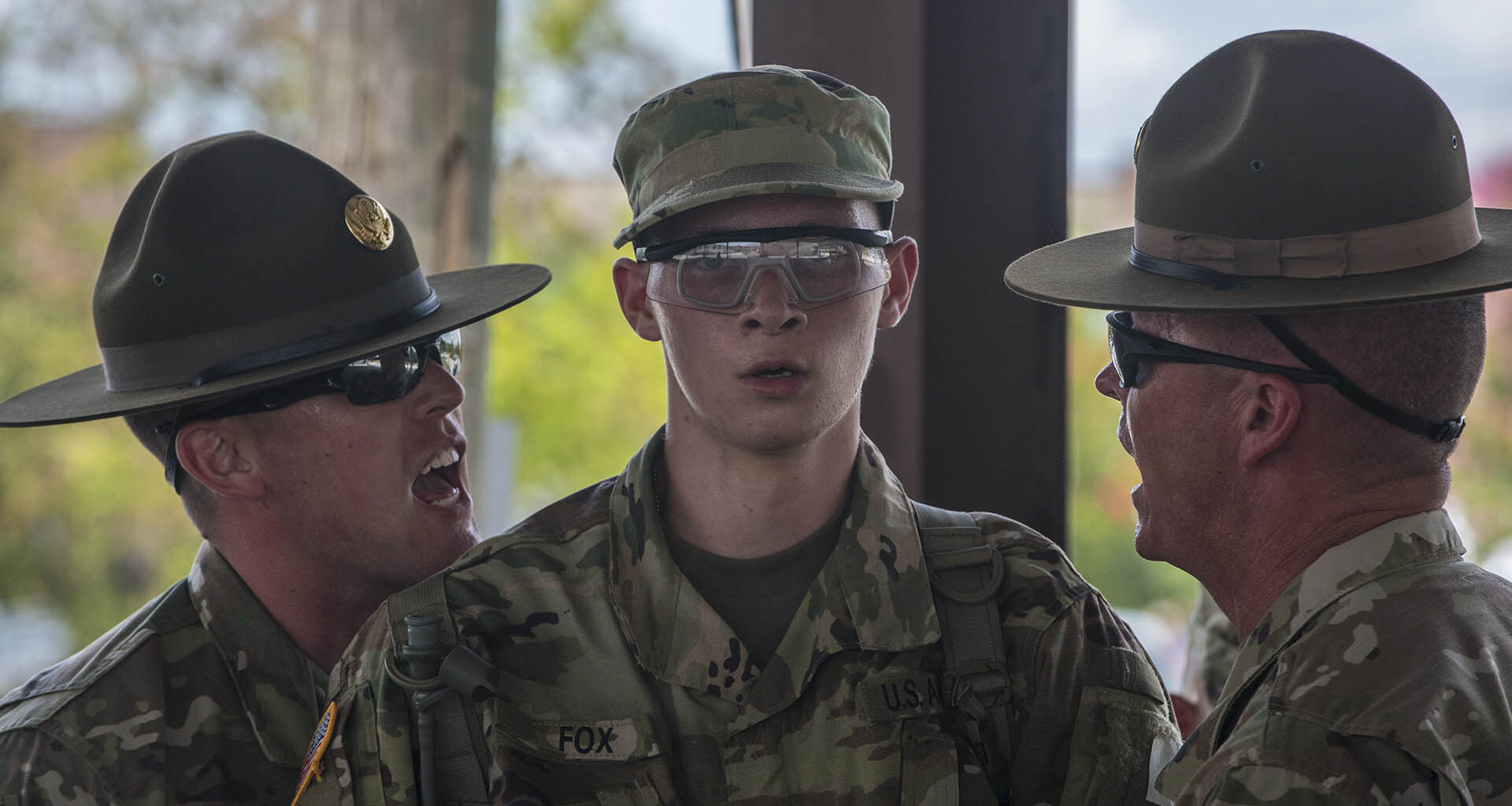It may sound counterintuitive, but sometimes you have to make a mess to teach Army trainees how to keep things clean.
The practice is known as “bay tossing,” in which drill sergeants can overturn trainees’ mattresses or bunks, empty the contents of their wall lockers on the floor, knock over garbage cans, or take some other actions to force trainees to clean up.
But one Army training unit at Fort Benning, Georgia, briefly prevented drill sergeants from tossing bays after things got out of hand and wall lockers were turned over and a desk was broken, a source with knowledge of the matter told Task & Purpose.
Two memos recently shared on social media indicate what happened. A July 31 memo from Col. Christopher J.C. Hallows, commander of the 197th Infantry Brigade, announced that bay tossing was “strictly prohibited.” The unit is currently tasked with training infantry soldiers as part of One Station Unit Training, which combines Basic Combat Training with Advanced Individual Training for several military occupational specialties.
 The aftermath of “bay tossing” during Army basic training. This is not the incident that prompted the commander of the 197th Infantry Brigade to briefly ban bay tossing. Photo courtesy of Jonathan Huff.
The aftermath of “bay tossing” during Army basic training. This is not the incident that prompted the commander of the 197th Infantry Brigade to briefly ban bay tossing. Photo courtesy of Jonathan Huff.
“Drill sergeants will not ‘toss’ the bay to include flipping mattresses, knocking over wall lockers, touching and/or damaging Trainee personal items or equipment,” the memo says. “Drill sergeants will not use bay ‘tossing’ for any reason to include methods of corrective action.”
Hallows did not write specifically what prompted the move, but his memo warns that abuse of trainees violates Army principles, disrupts good order and discipline, and destroys a positive training environment.
Then, just days later, Hallows issued an Aug. 3 memo rescinding the ban on bay tossing that did not include any explanation for the abrupt reversal.
Both memos are authentic and came after a recent review by the brigade command team, said Jennifer Gunn, a spokeswoman for the Maneuver Center of Excellence and Fort Benning.
“During a recent training cycle, a ‘bay toss’ resulted in damage to both government and trainee personal property,” Gunn told Task & Purpose. “This event drove the brigade to consider a change in how these events are executed. After additional review, the command team determined the behavior (the property damage) was covered in existing policy regarding good order and discipline and treating soldiers with dignity and respect and they rescinded the memo.”
If used correctly, bay tossing can be an effective and memorable way to teach trainees how to do something correctly, said Army Sgt. 1st Class Phillip Dobbins, who served as a drill sergeant from 2007 to 2009 at Fort Leonard Wood, Missouri.
“The purpose was to teach them that you did not achieve the standard, and sometimes you have to start back from the beginning until you get it right,” Dobbins told Task & Purpose. “And you do it over and over — very repetitive.”
 This March 12, 2024, photo from the U.S. Army Maneuver Center of Excellence at Fort Benning, Georgia, shows Army trainees beginning One Station Unit Training. Army photo.
This March 12, 2024, photo from the U.S. Army Maneuver Center of Excellence at Fort Benning, Georgia, shows Army trainees beginning One Station Unit Training. Army photo.
Bay tossing teaches trainees to get little things correct so they don’t mess up when they have to do more complicated tasks, said retired Army Sgt. 1st Class Jonathan Huff, who served as a drill sergeant from 2017 to 2019 at Fort Benning in Georgia.
Each trainee learns how to neatly fold, roll and hang up their clothing in their lockers, along with the proper way to make their beds, Huff told Task & Purpose. Doing so teaches trainees how to follow directions.
“That’s how you start the snowball effect of discipline,” Huff said. “A lot of these kids coming in have never been disciplined a day in their life. So, you’ve got to start with the little things and hardball them. You hardball the little things and the big things become easy. So, now I’m not at the firing range six weeks later wondering if this dips—t is going to blow my head off because he can’t follow directions,”
Huff said he didn’t receive any official training on bay tossing, adding, “I just used common sense.”
He mainly used the technique when the trainees’ bay smelled bad.
“And I’m like: All right, so what are you little dirty birds hiding?” Hoff explained. “So, I used it as a method to make them clean their s—t.”
Top Stories This Week
In addition to emptying wall lockers and flipping bunks, Huff would sometimes find shaving cream or shampoo left in the latrine, so he would use it to draw sad faces on the mirrors for the trainees to clean up. He would also kick over the garbage can if the trash had not been taken out.
“They learned real quick to take the trash out in the morning,” Huff said.
He tried to avoid tossing trainees’ bedding, clothing, and personal gear into a massive heap in the center of the bay because it’s not hygienic, he said. For example, trainees could end up sleeping in someone else’s sheets.
“Now you don’t have the correct boots,” Huff said. “You have different uniform bottoms and tops now because you didn’t get the right ones back. If I tossed somebody’s locker, all their s—t got tossed right in front of their locker. And that would be their key to put their s—t back together the proper way.”
Huff said that after the first few weeks of training, he typically no longer needed to resort to bay tossing because his trainees had “learned their lesson.”
“It worked for what I did, just little things to keep them on track,” Huff said. “Sometimes, you need a tune-up. You walk in, ah, it’s getting a little funky in here. All right, I’m going to take my anger out on this bay.”

Task & Purpose Video
Each week on Tuesdays and Fridays our team will bring you analysis of military tech, tactics, and doctrine.
Jeff Schogol is a senior staff writer for Task & Purpose. He has covered the military for nearly 20 years. Email him at schogol@taskandpurpose.com; direct message @JSchogol73030 on Twitter; or reach him on WhatsApp and Signal at 703-909-6488.

